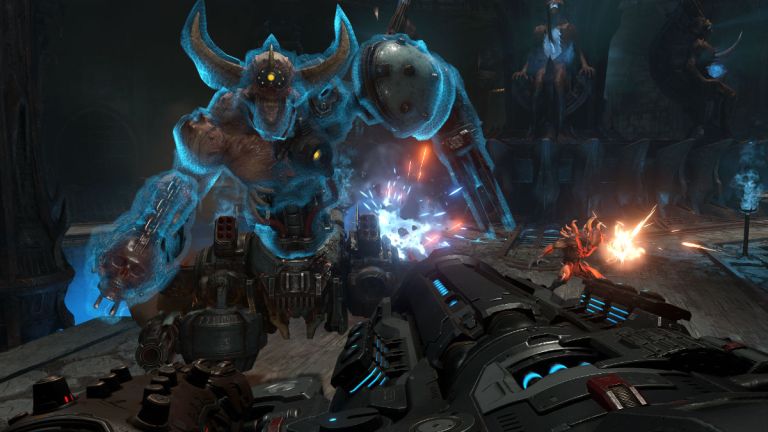How Doom Eternal Aims to Be Bigger and Better Than Its Predecessor
Doom Eternal is id Software's change to improve on 2016's Doom and the studio isn't taking that for granted.

DOOM (2016) was a lean, mean, lightning-fast corridor shooter that commanded the attention of the gaming community with its sharp visuals, blistering gameplay, and thunderous soundtrack. It won several awards, including Best Music and Best Action Game at the 2016 Game Awards, sold millions of copies across multiple platforms, and was received well by critics.
But despite such a successful venture, id Software believes that there were many ways that the game could be improved upon, which they endeavor to address in the forthcoming sequel, DOOM Eternal, which Den of Geek got to play for three hours at a preview event last week in San Francisco (check out our E3 gameplay impressions here, as well).
“We feel like, objectively, there were things we could have done better to expand the scope of [DOOM 2016],” says DOOM and DOOM Eternal game director Hugo Martin. “We really didn’t have a lot of locations to take you to in DOOM 2016. You kind of only went from Hell to Mars, Hell to Mars. So in DOOM Eternal, you see more and do more in the first three levels than you do pretty much in the entirety of DOOM 2016, and that’s just the beginning. It’s a bigger game in every possible way.”
Martin also acknowledges that DOOM‘s gameplay had some clear weaknesses: “I think too many players were able to fall into a very repetitive play style,” he admits. “I think if you were skilled at first-person shooters, you loved DOOM 2016. But for some people who aren’t that skilled, we want to make sure that everybody has the same kind of awesome experience and not just the skilled players.”
Read More: The Games You Need to Play in 2020
With DOOM Eternal, id has doubled down on the approach they took with DOOM: the game is meant to be played a certain way, and if you refuse to comply, you will die. A lot. Speaking to Martin about the game’s difficulty, it’s clear that id wants this sequel to be a real challenge for players.
“I think that the game’s job is to make sure that the player can’t succeed in playing the wrong way, and to teach them how to play the right way,” Martin asserts. “We’re comfortable with frustrating the player when they don’t do the right thing. I think you learn through failure. It’s like touching an electric fence. You get buzzed a couple of times and then you learn like, ‘Okay, I’m not supposed to touch that, move on.’ So as players play in a more defensive way or they try to hide behind rocks or treat it like a cover shooter, everything in the game is designed to basically try to kill you at that point. So as you die and you fail, then we’re kind of funneling the player into a play style that we know is going to be more fun.”
The idea of players learning from failure isn’t anything new, but there is nuance in the way id has chosen to curate the gamer’s experience. There are heavy-handed tutorials for virtually every gameplay mechanic in the game, which may seem like a blunt design choice on the surface but actually signals the developers’ confidence in the beauty and complexity of Eternal’s gameplay in motion. (You can watch some gameplay footage from our demo in the video below.)
“We don’t think that the fun of the game is figuring out how to play it,” explains Martin. “We think the fun of the game is mastering what it is you need to do to be successful. So it’s the mastery of those skills, not learning them.”
The team at id want you to have fun—just a specific kind of fun. As in DOOM, constant movement, relentless offense, and efficient resource management are the keys to victory. Glory kills regenerate health, chainsaw kills yield ammo, and setting baddies on fire grants you armor, so pushing forward and racking up kills in a deliberate way is the only way to survive.
Read More: How the DOOM Shotgun Changed First-person Shooters
The game throws a wide variety of enemies at you at once, with the stronger demons bearing weak points that are susceptible to different weapons and, which forces you to spread your adeptness across your entire arsenal. “This time around I think we’re encouraging weapon switching a bit more,” Martin says of Eternal’s more involved combat. “We see people using more mods in this game. There were a lot of people who beat the [first] game that didn’t even use a mod.”
These days, the idea of games using failure and frustration to teach players how to play correctly is most typically associated with titles like Nioh, Spelunky, and FromSoftware games. But Martin contests that all games—whether they be video games, board games, or sports—use failure as a teaching tool.
“[Take] any game. I use basketball, because it’s a great example. If I don’t play basketball correctly, if I don’t protect the ball, if I don’t rebound, if my team doesn’t play the right way, we’re going to lose. That’s it. The challenge and enjoyment of a sport like basketball is that I want to win. So when I lose because I don’t rebound enough, I’m motivated to become a better rebounder. It’s what funnels me into becoming a better basketball player, the desire to overcome the challenge.”
And id wants its players to be challenged, to get frustrated, to find fulfillment in sharpening their skills. The developers could have made DOOM easier and eliminated its learning curve, but they truly believe that the element of acquired mastery is the beating heart of the game. So whether you’re playing on easy or hard, you’re in for a climb.
“We want all skill players to be able to climb that mountain and achieve that level of mastery in DOOM that we’re going after,” Martin explains. “So even if you play on easy, or you’re playing on nightmare, everybody’s going to be playing the same way. It’s just that on easy enemies attack less and they don’t hit as hard. So it’s a little bit more manageable on easy. But I promise if you play the way we want you to play, you’re going to enjoy yourself. What was once challenging became easy, and that is the enjoyment. You know what I mean? I’ve mastered a skill and now I get to apply that skill to this world that they’ve created for me. That’s DOOM.”
Part of playing Eternal the “correct” way includes traversal, an element of gameplay that has been greatly expanded on this time around. “Last time, I think we had really good arenas, but nothing else in the level was necessarily that compelling,” says Martin. “So this time we think even the non-combat activities are just as engaging at times as the combat stuff. It’s important for us to challenge the player not just with combat but the level design itself and to make every aspect of DOOM Eternal engaging from beginning to end.”
In between combat encounters, players are presented platforming challenges that require nimble fingers and a keen eye. Double jumps and dashes are key, and there are often moments when the way forward isn’t clear until you scan the environment for a graspable wall hidden around a corner. Climbing feels a little clunky, and traversal as a whole isn’t nearly as engaging as the game’s combat, but the platforming sections do add variety and scope to the overall experience.
Read More: 25 PC Games That Changed History
While DOOM Eternal is strictly a skill-based game, there is a popular type of game that takes a different approach to progression—the loot shooter. In these games, the player—or their character, rather—gets stronger as a result of time investment. You grind, you level up, you find stronger weapons. Skill isn’t as important in these games as the time the player is willing to put in.
“DOOM is not that kind of game,” Martin asserts. “We don’t want to turn it into a looter shooter. But it’s not to say that those games also don’t demand that the player play them the right way. What I am trading often is massive amounts of time, which is also fun. I mean it’s saying that listen, ‘If you spend X amount of hours to level up your character to get to this level, we’ll allow you to play in that zone.’”
One of the most exciting new features Eternal offers is Invasion mode, reminiscent of the online component found in the Souls games. One to two players can invade another player’s campaign as demons and attempt to disrupt their progress. Players must choose to opt into the feature to be invaded. The invaders and the Doom Slayer will compete for a bounty, which can be used to purchase cosmetics in the game’s store.
“It presents like a dynamic difficulty challenge for the Slayer,” Martin explains. “So it’s for people who want that kind of experience. On the Slayer’s end, if you’re really good at the game, you’re going to want to open it up to Invasion to challenge yourself even more. If you’re a demon, it gives you the opportunity to just grief players. It’s just log on and grief players, troll them. I think a lot of people like to do that.”
While Invasion mode looks to add a new wrinkle to the DOOM experience, one of the franchise’s oldest staples returns in the form of cheat codes. “There’s all kinds of cheat codes that you could unlock,” says Martin. “And that’s just for replay value. You could dive back through the game and experience it however you want with whatever zany cheat codes you want. Just to have fun. Just like in classic DOOM.”
And now is a great time to be a classic DOOM fan. With the release of DOOM 64 on modern consoles as a pre-order bonus for DOOM Eternal, the entire DOOM series is available on one console for the first time ever.
“I mean, as a gamer I just wanted that for so long,” says Martin. “Just to be able to play DOOM, DOOM 64, DOOM II, DOOM III anytime I want on my PS4 is awesome. So I think it’s really exciting for fans. Those games hold up, they’re still really fun, DOOM 64 is like one of my favorite DOOMs. And I just love that now this whole new generation of gamers gets to experience it.”
DOOM Eternal releases on March 20 for PlayStation 4, Xbox One, PC, and Stadia, with a release planned for the Nintendo Switch at a later date.
Bernard Boo is a freelance contributor. Read more of his work here.
